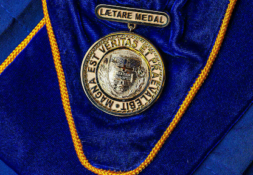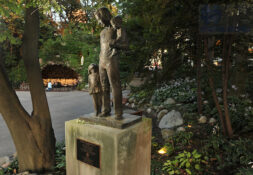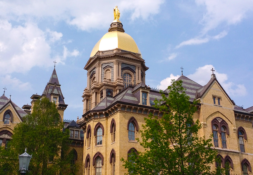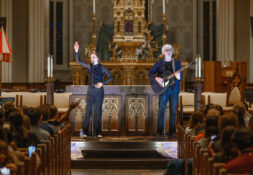Students, faculty, and alumni voice opinions on the controversial Campus Crossroads Project
Announced on January 29, 2014, the Campus Crossroads Project has stirred up both contentious conversation and the area around Notre Dame’s iconic football stadium. Construction began in full force on November 23 amidst an ongoing debate between staunch supporters and a myriad of dissenting voices.
The university sent an email on November 20 detailing the inconveniences to be posed by the ensuing construction, including the occupation of all parking lots near the stadium other than those south of the Joyce Center, as well as the closing of sidewalks on the stadium’s east and west sides. The message concluded with the university’s standard description of the anticipated revenue and benefits to be generated by the Project.
In light of construction’s commencement, the Irish Rover conducted a survey to gauge Notre Dame students’ opinions regarding Campus Crossroads. Out of 262 total responses to the survey, 41 students approved of the Project, 112 disapproved, and 109 approved with reservations. Although a majority of students indicated at least some approval of the Project, the comments included in the survey revealed strong opposition.
When asked whether or not they believe Campus Crossroads will improve the Notre Dame student experience, 57 percent of students said that it will, while 43 percent said that it will not.
Among those who approved of the Project, a vast majority of students cited new amenities for students as its main benefit. A few students mentioned that the Project seems to make more efficient use of campus space, and many noted that it will improve the stadium experience.
For the students who disapproved, the two largest concerns were that the Project is too expensive and that construction will move the main commencement ceremony to the Purcell Pavilion. Several students responded that they would favor the Project, except for the fact that ongoing construction will limit family tickets to the main graduation ceremony.
“It is becoming increasingly difficult to appreciate the Campus Crossroads Project when I feel that the Class of 2015 is being completely disregarded and gypped of the best senior experience possible,” senior Amanda Peña told the Rover. Peña is spearheading an effort by the Class of 2015 to pause construction for graduation.
A Facebook page that Peña created, ND Students for Stadium Commencement Coalition, had garnered 484 likes as of November 28. According to Peña, many Notre Dame seniors told her that the construction will negatively affect their families’ commencement weekend plans. She also asserted that students have expressed frustration with the lack of transparency from the administration regarding commencement planning and construction inconveniences.
One survey respondent articulated similar concerns: “I disagree with the way the project has been communicated to students, especially regarding commencement,” the student said. “The university knew we would not be graduating in the stadium. But they waited to tell us until after we invited our families, made hotel reservations, and bought plane tickets.”
Another common theme in survey responses was the belief that university resources would be better spent elsewhere.
“If Notre Dame is going to spend $400 million, spend it improving what we already have: renovating the dorms, giving more money for club events, getting better study spaces, improving health and education resources on campus,” said Lucinda Krahl, a junior living in Farley Hall.
“It seems superfluous. Most of the residence halls could use improvement; mine has been in and out of hot water for the last few weeks,” sophomore Anna Busse, president of Pangborn Hall told the Rover. “Some of the parking lots are in bad shape, tuition is always climbing and so is room and board. There is more need in other areas that would have a more direct impact on today’s students.”
“Dormitories that are badly outdated and in need of renovations—like Dillon, Alumni, and Morrissey—should be provided with university funding before a project like this is undertaken,” one student wrote in the survey.
Another student agreed that resources would be better spent elsewhere: “This project moves our university away from its central mission of raising up its students, not its facilities. The money could be better spent on scholarship programs and dorm renovations.”
“[T]here are some students, like me, who don’t even know if they can financially return to Notre Dame for another year,” Krahl added. “If Notre Dame truly cares about its students, then the administration should lessen the burden on us, or at least ask for our input before wastefully spending $400 million.”
Another student also pointed out a lack of equal fund distribution: “The discrepancy between the low-end and high-end residence halls is disgusting … Instead of harassing my parents for money to fund this vanity project, use some of that mad money to renovate the ailing dorms, or make our board costs reflect our res[idence] hall quality.”
Many students, however, argued that the anticipated benefits of the Project will outweigh the costs.
“[I]t’s a long overdue project, and this isn’t the first building Notre Dame has built which is very expensive. Nobody has complained about those buildings,” one noted.
“A lot of universities have [facilities] … similar to this. For students and alumni, seeing a modernized and expensive stadium that competes with other well-established football programs will really make them proud to be an Irish fan,” said Brent Swanberg, a junior in Keough Hall.
One student expressed similar support: “A second student union will be nice since LaFortune is very crowded. The project is an interesting combination of academics, extracurriculars, and athletics. It is a wise upgrade of our most prominent structure in the eyes of the rest of country.”
“The Crossroads project utilizes a huge building on campus that is only otherwise utilized for the 5 home football games and (formerly) graduation,” said Louis Bertolotti, a sophomore in Keenan Hall. “It shows the university’s commitment to academics and proves that student comes before athlete in student-athlete. It is a bold move that has made other schools across the nation to take notice.”
“[I]t will improve student experience with the addition of a student union … The only place that currently exists of this nature is [LaFortune], which is not big enough to accommodate the student body,” Jimmy Firth, a junior in Keough Hall, told the Rover.
Another student claimed that a renovated stadium will improve the quality of the university’s football program: “The stadium is wonderful, but it needs to be updated to bring in the best recruits. Notre Dame is no longer the powerhouse that has exclusive television coverage from coast to coast; all good teams have that ability,” the student said. “Because we’ve lost this advantage in recruiting, we now need to heighten our amenities to bring in student athletes.”
“[I]f Notre Dame wants to stay relevant, it needs to modernize the football program. Not many 18-year-old top recruits want to come play for ‘tradition,’” Swanberg added. “They would rather play for a flashy and sexy football program. Getting the best players is crucial to being the best team.”
In the ongoing debate over Crossroads, many—including, notably, Rover faculty advisor Fr. Bill Miscamble, CSC—have claimed that the Project shifts the center of campus from Main Building to the football stadium, reflecting the university’s misdirected priorities.
“This Project must be opposed forcefully,” wrote Miscamble in the February 20, 2014, issue of the Irish Rover. “Not only is it poorly conceived and designed, but it damages the true mission of the university.”
Alex Slavsky, a sophomore in Knott Hall, told the Rover that he has similar concerns.
“[The Project] will have dire effects on the spiritual, academic, and social life of the campus,” he said. “It will direct attention from the heart of the Notre Dame campus, the Basilica and the golden dome to the stadium, which has and always should stand only as a complement to the overarching mission of the university: to educate the mind and heart for citizens of this earth and heaven.”
“As a Catholic university, our mission is to bring Christ to others; this is non-negotiable to the contrary,” said Marwan Bishtawi, a Keough Hall junior. “This project is a monument to our administration’s apparent focus on wealth, rank, and status. Further, our administration has seemingly turned a deaf ear to considerable student and faculty outcry regarding said project, which blatantly alienates and disrespects those upon whom this university is built.”
“Growth is a good thing [but] the center of the university should not be the venue by which this institution accumulates a huge sum of its profit,” freshman John Kill asserted. “The center of this university should be something that signifies the mission of the university, striving to prepare and educate young men and women who are seeking to make a difference for the better in this world, in combination with the Catholic ideals that should be the foundation of this institution.”
Lyons Hall junior Katie Taylor also noted a possible shift in perspective. “While I have no doubt that the Campus Crossroads Project will be beneficial for the services it will provide, I see its name as an indication that the administration believes the heart of our campus is the stadium, and consequently disregards our academics, our fight for social justice, and our Catholic identity,” Taylor said.
Notre Dame faculty members also expressed their opinions of the Project to the Rover.
Walter Nicgorski, Professor Emeritus of the Program of Liberal Studies, a member of the faculty Senate, and a Rover faculty advisor, expressed to the Rover his concerns about how the Project unfolded: “In two important instances within the past year—the changes in the 403b retirement plan for faculty and staff and the proposed Crossroads Project—the administration has not sought broad faculty advice and failed to build community consensus before these major steps.”
Professor of Philosophy Ted Warfield agreed that the faculty should have been consulted before Crossroads was finalized.
“Like most important decisions at Notre Dame, the key decisions about the Crossroads project were made by a group of about 8 University ‘leaders’ and without serious faculty input,” Warfield told the Rover. “Instead of getting faculty input into big decisions, the leadership at Notre Dame gets reactions from the faculty (and others) after issues are closed for debate. The administration pretends that this counts as consultation with the faculty.”
Philip Bess, Professor of Architecture, noted to the Rover that the costs will likely outweigh touted benefits.
“It’s an odd project: glom three big new buildings onto an 80,000-seat football stadium to make one giant new building as a new campus center—especially odd when Notre Dame already has a beautiful, historic, indeed iconic campus center,” he said. “I’m sure that if the revenues the Crossroads Project will purportedly generate were to fund full scholarships for every Notre Dame graduate architecture student—a big ‘if’—I would feel better about it. But surely there’s another way.”
Professor of Philosophy Curtis Franks articulated concerns about the mixing of academics, athletics, and student life. “Already these things are run together more than I care for them to be,” he said. “Each might be important, but the suggestion that they have something to do with each other is probably not conducive to the flourishing of any of them.”
“Crossroads is projected to have a cost of $400 million,” Warfield continued. “I have confirmed through my own consultations what Professor Miscamble—among others—has said about this projected cost: Notre Dame could provide first rate buildings for each of the academic programs scheduled to move into Crossroads and also build yet another student recreation center for a little over half of what will be spent on the Crossroads project.”
Franks also noted that the Project will have some benefits. “[W]e certainly need more classroom and lab space on campus. Although the Campus Crossroads Project is probably not the most cost effective way to provide this needed space, I look forward to fewer restrictions on course scheduling.”
“It just seems symbolically wrong to monumentalize college athletics in this manner and at this scale, especially given Notre Dame’s Catholic mission and her promotion of the scholar-athlete ideal,” Bess elaborated. “I know many loyal Domers—avid Irish football fans—who share this misgiving, and worry that the administration, the Fellows of the University, and the C.S.C. themselves don’t recognize the problematic symbolic import of the Crossroads Project. No one at the top seems to have made the connection between the Crossroads and the legend of the great but tragic blues-man Robert Johnson.”
Several Notre Dame alumni spoke with the Rover regarding the anticipated effects of Campus Crossroads.
“Crossroads is a mammoth set of buildings that will move the physical—and, shall I say, spiritual—center away from the Basilica and Golden Dome,” said Jim Thunder (’72). “The decision to build Crossroads took very little time. If this decision was the result of a long, consensus-building process of the various constituencies of the university, I am unaware of it.”
A graduate from the class of 1983, and a parent of a current Notre Dame student, noted that he saw both benefits and issues with the Project. “[I]t’s hard to imagine we don’t have more critical needs for $400 million than that project, such as a new library. For me, their justifications … had the feeling of ‘thou doth protest too much’ in an effort to hide the truth that, in part, it is designed to enhance the Stadium experience.”
Dan Boland (’55) argued that the Project illustrates Notre Dame’s misplaced priorities: “[T]he Project seems a disconcerting public monument to the ongoing process of the marginalization and de-emphasis of the faith in the public life and radical identity of the university,” he told the Rover.
“The grandiose Crossroads Project … is the voice of school elevating football and the gush of money anticipated from the new premium accommodations to pre-eminence,” Bill Dempsey, valedictorian of the class of 1952 and chairman of the Sycamore Trust told the Rover, “and it is an embarrassing, chest-thumping ‘see how much we can spend’ display of Notre Dame’s wealth. It is precisely the opposite of what a Catholic school’s major buildings should say.”
Though the Crossroads Project is now underway—and it is evident that its progress will not be halted—survey data and collected comments reveal that many students, faculty, and alumni remain unconvinced that all of these changes will be for the better.
Alexandra DeSanctis is a junior political science major who can’t wait until Christmas. Email her at adesanct@nd.edu.






Leave a Reply